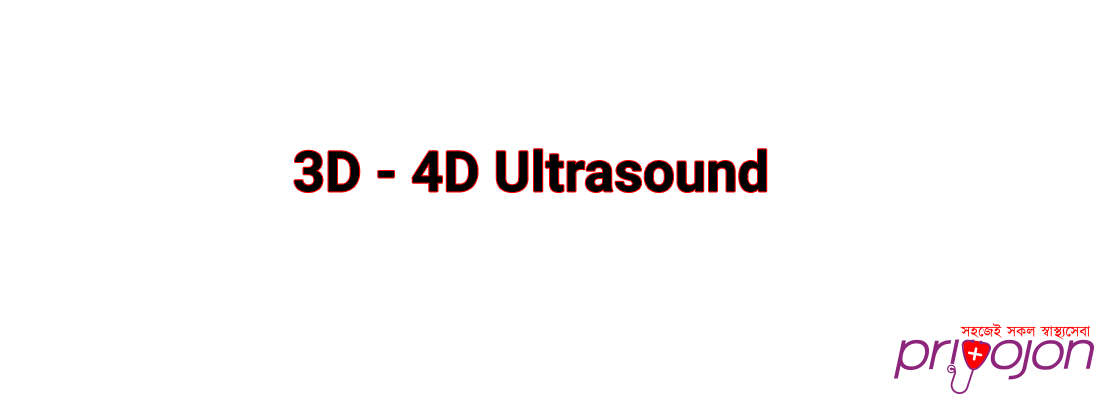
Overview
Medically reviewed by Dr. Rabeya Afroz Shomi
What is 3d - 4d Ultrasound?
A highly effective clinical tool, ultrasound allows doctors to view images of the foetus while it is inside the mother’s womb. This clinical technique makes use of sound waves to produce images. Ultrasound imaging allows real-time imaging of the baby. It is a non-invasive procedure and does not involve the use of ionizing radiation, which can prove to be harmful to the foetus. Moreover, ultrasound is interactive, that is, it allows the doctor to capture pictures of the foetus from different angles.
While initially, only 2D ultrasound was available to pregnant women, slowly and steadily 3D ultrasound and 4D ultrasound techniques were also invented. While 2D ultrasound captures images in a single plane, 3D ultrasound allows one to obtain volume data. Thus, in this case, 2D images are taken from various angles and consequently integrated together with the help of a computer software, thus producing a set of 3-dimensional pictures. 3D technology thus deals with collecting data, analyzing it and finally displaying it.
4D ultrasound allows one to view a video which streams live, thus it is possible to experience the foetal heart beating and viewing the blood flow of the heart.
Both 3D and 4D ultrasounds increase the chances of detecting fetal defects at an early stage. Defects like a cleft lip or skeletal as well as neural tube defects are easily detected.
How is the Ultrasound done?
3D and 4D ultrasounds are quite safe and allow parents and doctors to view the baby while it is still in its early stages of development in the womb. Moreover, 3D or 4D ultrasound can effectively detect birth defects which otherwise may not appear on a 2D ultrasound.
While ultrasound is done primarily for medical reasons, that is, to check fetal development or any abdominal anomalies in the case of a medical condition in patients, it is often misused when expecting parents are offered keepsake ultrasound videos of their child. It has to be understood that exposure to very high ultrasound can be harmful to the baby. Thus, the advantages and disadvantages of ultrasound should be thoroughly discussed with the doctor, before opting for a 3D ultrasound or even a 4D ultrasound.
The procedure of the ultrasound test is fairly simple. The patient or an expecting mother is asked to lie down and expose their stomach. A particular type of gel is then applied on the belly. The gel helps sound waves create effective images. Afterward, a probe is placed on the stomach and is moved around in order to get a set of varying images from different angles.
One should know that while getting a 2D ultrasound is standard pregnancy procedure, one may opt to get 3D or a 4D ultrasound. Both are optional and are generally only done in the case of medical reasons.
Who is eligible for the Ultrasound?
An expecting mother generally undergoes a 2D ultrasound, but can also choose to have a 3D or a 4D ultrasound as well. An ultrasound may be done multiple times during a pregnancy, recording the different stages effectively.
Who is not eligible for the treatment?
A 3D or a 4D ultrasound may be a bit risky for the baby, thus it is only recommended in case of any medical problems with the foetus.
Are there any side effects?
Although quite safe, ultrasound leads to a bit of tissue heating. It may also result in the development of gas pockets in the tissues. Unregulated ultrasound is discouraged, even though no severe health implications have been recorded in the past 20 years. Before opting for a 3D or 4D ultrasound its implications should be discussed with a doctor.
What are the post-treatment guidelines?
Ultrasound is simply a non-invasive imaging test, there is no post-test recovery required and thus no guidelines are available as such.
How long does it take to recover?
As ultrasound is simply a non-invasive imaging test, it does not require any form of recovery.
Are the results of the treatment permanent?
As this is an imaging test, there is no scope for permanent results from it.
What are the alternatives to the treatment?
One may choose to have a 2D ultrasound instead of a 3D or 4D ultrasound. 5D ultrasounds can also be opted for as well.
Key Highlights
Safety: High
Effectiveness: High
Timeliness: High
Relative Risk: Very Low
Side Effects: Very Low
Recovery Time: Very Low
